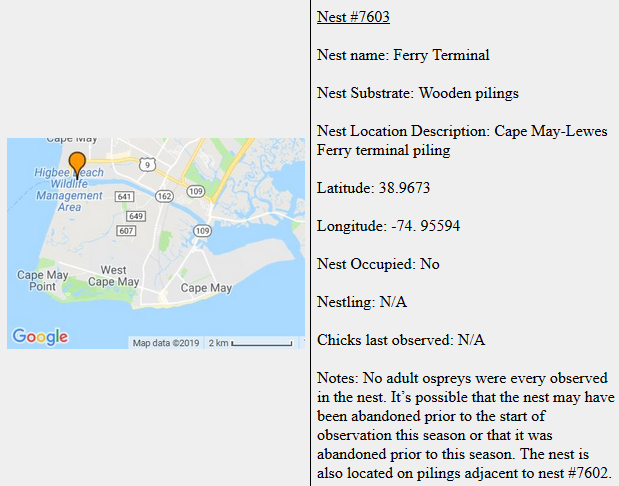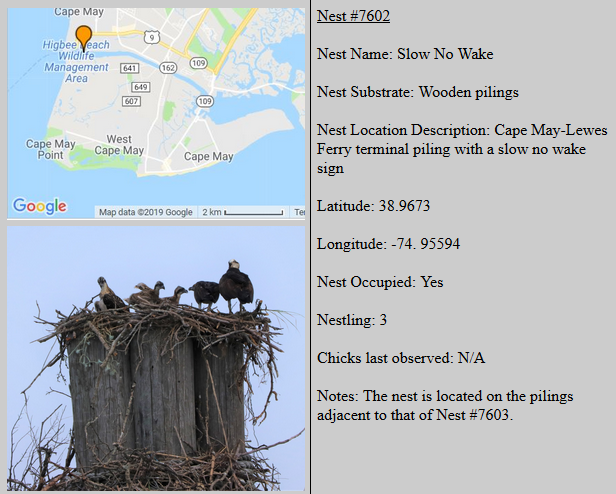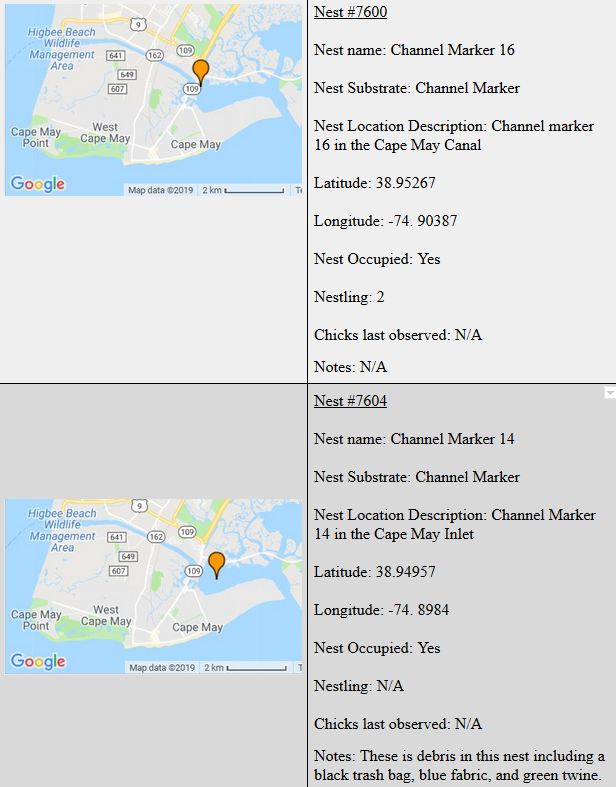Bird Reports And Osprey Nest Observation From The American Star; 2019

Introduction
Citizen Science is a project that depends on the collection and analysis of data by members of the general public. These large projects are often collaborative with professional scientists. Citizen science typically is used in the natural sciences, but it can be used in a variety of fields. Many volunteer programs and studies exist that depend on the collection of data by people in the public (Cornell Lab of Ornithology 2007). One of the largest groups of citizen scientists are bird watchers, and programs have been developed to take advantage of this data source.
For this independent project, I participated with two global online communities that collect data through citizen science programs. The first was OspreyWatch, which is a group with a focus on breeding ospreys (Pandion haliaetus). The second is eBird which takes bird sighting reports for every species. Through these online sites, I kept records of all the bird species and number of birds reported from the trips. I also reported all of the osprey nests that could be observed from the trip, and I recorded important details and events for the nests. In addition to keeping track of data for the trips that I attended, the data was also submitted and will be used towards larger studies.
Background
The two programs I used in this project were eBird and OspreyWatch. eBird is a program run by The Cornell Lab of Ornithology and is the world’s largest biodiversity-related citizen science project. Every year, there are well over 100 million bird sightings reported to the program. The program has hundreds of partner organizations, thousands of experts, and hundreds of thousands of users. Birders and casual observers that use the app report what they saw, when they saw it, where they saw it, and details about how they were observing the birds. The program also allows for photo and audio recordings to be submitted. The data reported is used to understand bird distributions, abundances, habitat use, and trends. All data recorded by the program is free to access and has been used in a number of conservation based decisions, peer-reviewed papers, student projects, and other forms of bird research (About eBird).
OspreyWatch is the other program used in this project. OspreyWatch is another global cooperative program with a large community of observers who report on nesting ospreys and is run by The Center for Conservation of Biology. The main goal of OspreyWatch is to collect data on nesting ospreys in order to help understand issues affecting both the ospreys and the aquatic ecosystems that they are dependent on. The three main issues that are being addressed are global climate change, depletion of fish stocks, and environmental contaminants. Ospreys only feed on freshly caught fish, so their nesting success is highly dependent on the availability of this food source. In addition, as a top predator, they are highly affected by aquatic pollution and contaminants. Ospreys often serve as an indicator of the health of aquatic ecosystems that they inhabit, so by understanding the distributions of these birds and watching their nesting success, it is possible to help monitor the issues described (The Center for Conservation Biology 2019).
Methods
For this project, data was collected for both OspreyWatch and for eBird. Data was collected from the boat, The American Star, and was collected during the whale and dolphin cruises. Three cruises occurred most days with a 2 hour morning cruise that stayed close to shore, a 3 hour cruise that traveled inshore and offshore, and a 2 hour evening cruise that stayed close to shore. Locations visited during each cruise varied based on weather conditions and marine mammal reports. Data was recorded only on trips that I attended, which would be approximately 2-3 days a week with 1-2 trips a day from May 27th to July 30th. Binoculars were used for making observations, and a Canon camera with a 75-300mm zoom provided by the Whale and Dolphin Conservation was used to photograph bird sightings while collecting marine mammal data.
For eBird sightings, the Apple mobile app was used. The app tracked and mapped the entire trip and provided a checklist of species in the area. It also timed the entire trip. The number of each species was recorded for each sighting, and the details were submitted for any noteworthy observations or rare species.
For OspreyWatch, notes were taken on the location of the nest in longitude and latitude, the type of nesting material, any noteworthy observations, and any information on the status of the nest (i.e.-number of chicks, date of fledging, etc.). Notes were recorded by hand with the associated date of observation. Photos were taken when possible of the nests. All recorded data was then uploaded to the online site.
Results
During this project, 9 osprey nests were observed between the Cape May Canal, Harbor, and Cape May Inlet (Fig 1). Of the 9 nests, 5 had confirmed chick sightings, 2 were known to be occupied by the adult bird , 1 nest was thought to be occupied, and 1 nest was either never active or was abandoned. The 2 nests that were definitely occupied had both adults present at one point or another, but it was difficult to view the chicks based on the angle of the channel marker and/or the distance the nest was from the passing boat. The 1 nest that was thought to be occupied was located on top of a telephone pole, which made it nearly impossible to determine whether chicks or adults were present on the nest, but an adult was often observed perched next to the nest on a telephone wire (Fig 2).
For the eBird data, 17 checklists were reported over 11 dates and covered 589.77 miles. 33 different species were reported during these trips including 9 sightings that were considered higher than expected for the location and time of year. The most common bird sighted was the laughing gull (Leucophaeus atricilla). All laughing gull sightings are marked with an ‘X’ because too many individuals were sighted to count (Fig 3).
Figure 1. Map of Cape May Island with the osprey nests reported during this study marked in red.
Figure 2. OspreyWatch Nest Summaries





Figure 3. eBird Sighting summaries. The designation of an ‘X’ before a species was observed, but the number wasn’t indicated because there were too many to count or they were only heard.
Date: 07/01/2019
Trip: PM and SS
# of Taxa Reported: 11
Duration: ~300 minutes
Distance: ~40.00 miles
Protocol: Traveling
Checklist:
- 40 Canada Goose
- 3 American Black Duck
- 4 American Oystercatcher
- X Laughing Gull
- 2 Herring Gull
- 61 Great Black-backed Gull
- 6 Forster’s Tern
- 5 Snowy Egret
- 4 Black-crowned Night-Heron
- 20 Osprey
- 2 Bald Eagle
Notes: Location services were not available
Date: 07/02/2019
Trip: PM and SS
# of Taxa Reported: 13
Duration: 422 minutes
Distance: 56.62 miles
Protocol: Traveling
Checklist:
- 24 Canada Goose
- 5 Rock Pigeon
- 3 American Oystercatcher
- 1 Willet
- X Laughing Gull
- 2 Herring Gull
- 20 Great Black-backed Gull
- 20 Least Tern
- 30 Forster’s Tern
- 1 Double-crested Cormorant
- 1 Black-crowned Night-Heron
- 22 Osprey
- 1 Purple Martin
Notes: N/A
Date: 07/02/2019
Trip: N/A
# of Taxa Reported: 1
Duration: 2 minutes
Distance: N/A
Protocol: Stationary
Checklist:
- 2 Black Skimmer
Notes: Observed after the boat docked and the checklist for the day had been submitted.
Date: 07/08/2019
Trip: PM
# of Taxa Reported: 21
Duration: 419 minutes
Distance: 48.14 miles
Protocol: Traveling
Checklist:
- 30 Canada Goose
- 28 Mallard
- 2 Black Scoter
- 11 Rock Pigeon
- 2 American Oystercatcher
- X Laughing Gull
- 14 Herring Gull
- 9 Great Black-backed Gull
- 12 Least Tern
- 5 Common Tern
- 58 Forster’s Tern
- 8 Double-crested Cormorant
- 1 Great Blue Heron
- 1 Great Egret
- 2 Snowy Egret
- 1 Black-crowned Night-Heron
- 9 Osprey
- 3 Bald Eagle
- 2 American Crow
- 4 Tree Swallow
Notes: N/A
Date: 07/09/2019
Trip: AM
# of Taxa Reported: 21
Duration: 117 minutes
Distance: 18.08 miles
Protocol: Traveling
Checklist:
- 58 Canada Goose
- 5 Rock Pigeon
- 6 American Oystercatcher
- X Laughing Gull
- 6 Herring Gull
- 50 Great Black-backed Gull
- 6 Least Tern
- 3 Common Tern
- 39 Forster’s Tern
- 3 Double-crested Cormorant
- 18 Brown Pelican
- 2 Turkey Vulture
- 8 Osprey
Notes: N/A
Date: 07/09/2019
Trip: PM
# of Taxa Reported: 12
Duration: 212 minutes
Distance: 34.86 miles
Protocol: Traveling
Checklist:
- 56 Canada Goose
- 4 American Oystercatcher
- X Laughing Gull
- 2 Herring Gull
- 2 Least Tern
- 1 Common Tern
- 5 Forster’s Tern
- 6 Wilson’s Storm-Petrel
- 2 Double-crested Cormorant
- 12 Brown Pelican
- 10 Osprey
- 2 Red-winged Blackbird
Notes: N/A
Date: 07/12/2019
Trip: AM
# of Taxa Reported: 11
Duration: 116 minutes
Distance: 16.93 miles
Protocol: Traveling
Checklist:
- 1 American Black Duck
- 1 Black Scoter
- 3 Rock Pigeon
- 5 American Oystercatcher
- X Laughing Gull
- 2 Herring Gull
- 1 Common Tern
- 20 Forster’s Tern
- 6 Double-crested Cormorant
- 1 Snowy Egret
- 7 Osprey
Notes: N/A
Date: 07/12/2019
Trip: PM
# of Taxa Reported: 5*
Duration: 59 minutes*
Distance: 12.89 miles*
Protocol: Traveling
Checklist:
- 40 Black Scoter
- X Laughing Gull
- X Common Tern/Forster’s Tern
- 4 Wilson’s Storm-Petrel
- X Osprey
Notes: The recording of this checklist occurred started at 2:19pm, which was an hour into the trip. The numbers on this checklist are not completely representative of the bird sightings that were observed.
Date: 07/15/2019
Trip: AM
# of Taxa Reported: 7
Duration: 135 minutes
Distance: 15.91 miles
Protocol: Traveling
Checklist:
- 5 American Oystercatcher
- X Laughing Gull
- 2 Herring Gull
- 6 Common Tern
- 20 Forster’s Tern
- 5 Double-crested Cormorant
- 10 Osprey
Notes: N/A
Date: 07/15/2019
Trip: PM
# of Taxa Reported: 15
Duration: 188 minutes
Distance: 32.30 miles
Protocol: Traveling
Checklist:
- 5 Rock Pigeon
- 4 American Oystercatcher
- X Laughing Gull
- 2 Herring Gull
- 12 Great Black-backed Gull
- 1 Least Tern
- 5 Caspian Tern
- 3 Common Tern
- 18 Forster’s Tern
- 1 Wilson’s Storm-Petrel
- 7 Brown Pelican
- 1 Snowy Egret
- 4 Osprey
- 1 Barn Swallow
Notes: N/A
Date: 07/17/2019
Trip: AM
# of Taxa Reported: 11
Duration: 167 minutes
Distance: 16.29 miles
Protocol: Traveling
Checklist:
- 10 Canada Goose
- 9 American Oystercatcher
- X Laughing Gull
- 2 Herring Gull
- 4 Great Black-backed Gull
- 40 Forster’s Tern
- 20 Common/Forster’s Tern
- 3 Double-crested Cormorant
- 10 Brown Pelican
- 1 Black-crowned Night-Heron
- 8 Osprey
Notes: N/A
Date: 07/17/2019
Trip: PM
# of Taxa Reported: 7
Duration: 183 minutes
Distance: 33.13 miles
Protocol: Traveling
Checklist:
- 31 Canada Goose
- X Laughing Gull
- X Common/Forster’s Tern
- 4 Brown Pelican
- 1 Snowy Egret
- 1 Black-crowned Night-Heron
- 7 Osprey
Notes: N/A
Date: 07/19/2019
Trip: AM
# of Taxa Reported: 12
Duration: 122 minutes
Distance: 15.65 miles
Protocol: Traveling
Checklist:
- 8 American Black Duck
- 4 Rock Pigeon
- 1 Mourning Dove
- 12 Willet
- X Laughing Gull
- 2 Herring Gull
- 1 Great Black-backed Gull
- 4 Forster’s Tern
- 2 Double-crested Cormorant
- 1 Brown Pelican
- 5 Osprey
- 2 Bald Eagle
- 6 Barn Swallow
Notes: N/A
Date: 07/19/2019
Trip: PM
# of Taxa Reported: 9
Duration: 213 minutes
Distance: 32.15.29 miles
Protocol: Traveling
Checklist:
- X Laughing Gull
- 4 Forster’s Tern
- 1 Double-crested Cormorant
- 1 Brown Pelican
- 2 Snowy Egret
- 1 Osprey
- 1 Bald Eagle
- 3 Barn Swallow
Notes: N/A
Date: 07/22/2019
Trip: AM
# of Taxa Reported: 7
Duration: 153 minutes
Distance: 17.79 miles
Protocol: Traveling
Checklist:
- 4 Rock Pigeon
- X Laughing Gull
- 3 Herring Gull
- 12 Forster’s Tern
- 46 Common/Forster’s Tern
- 2 Double-crested Cormorant
- 6 Osprey
Notes: N/A
Date: 07/26/2019
Trip: AM
# of Taxa Reported: 11
Duration: ~180 minutes
Distance: ~25.00 miles
Protocol: Traveling
Checklist:
- 25 Black Scoter
- 3 Rock Pigeon
- X Laughing Gull
- X Least Tern
- X Common Tern
- X Forster’s Tern
- 1 Wilson’s Storm Petrel
- 1 Great Shearwater
- 7 Double-crested Cormorant
- 15 Brown Pelican
- 6 Osprey
Notes: Location services were not available
Date: 07/29/2019
Trip: AM and PM
# of Taxa Reported: 22
Duration: 374 Minutes
Distance: 46.72 miles
Protocol: Traveling
Checklist:
- 9 Canada Goose
- 3 Rock Pigeon
- 1 American Oystercatcher
- 2 Killdeer
- 3 Whimbrel
- 4 Semipalmated Sandpiper
- X Laughing Gull
- 35 Herring Gull
- 15 Great Black-backed Gull
- X Least Tern
- 7 Caspean Tern
- X Common Tern
- X Forster’s Tern
- 1 Wilson’s Storm Petrel
- 7 Double-crested Cormorant
- 2 Great Blue Heron
- 2 Black-crowned Night-Heron
- 2 Turkey Vulture
- 18 Osprey
- 2 Bald Eagle
- 5 American Crow
- 6 Barn Swallow
Notes: N/A
Conclusion
The purpose of this project was to utilize the whale and dolphin cruises as a way to report bird sightings to eBird and to report the osprey nests to OspreyWatch that would otherwise be somewhat inaccessible to those without access to a boat. This did provide a unique experience in order to use these programs. As a result, 9 new nests were able to be reported to OspreyWatch, and 17 checklists were submitted to eBird.
That being said, there are some biases to the data. With the osprey nests, it was difficult to observe them because the sightings were brief since the boat was always moving. The nest that was closest to the boat when it was docked, and the nest near the ferry terminal were the most updated since the boat was either moving slowly or not moving at all based on the tour. With the eBird data, there was a bias based on the number of people on the boat and the number of dolphins sighted. On a day with several interns, it was easier to spend more time bird watching. On days when I was the only intern, there was less time to dedicate to reporting bird sightings. The dolphin sightings also made a huge difference. On a day with a lot of dolphin sightings or a day with very active dolphins, there was again less time to spend searching for birds.
Based on these biases, there are ways to improve the data collected. For OspreyWatch, it may have been helpful to print out the map with all the reported nests, so I could have planned my observations better. For eBird, I should have made notes about the naturalist, the number of interns, and the number of dolphin sightings to help explain why some sightings included a larger number of taxa than others.
Zoe Korpi – Penn State University
Intern at Cape May Whale Watch and Research Center
Literature Cited
The Center for Conservation Biology. (2019). OspreyWatch. Retrieved from http://www.osprey-watch.org/about
Cornell Lab of Ornithology. About eBird. Retrieved from https://ebird.org/about
Cornell Lab of Ornithology. (2007). What is this, “Citizen Science”? Retrieved from http://www.birds.cornell.edu/citscitoolkit/about/SYNTHESIS%20Defining%20Citizen%20Science.pdf
